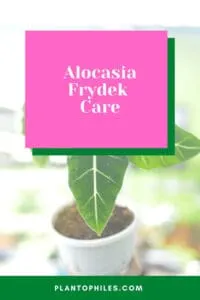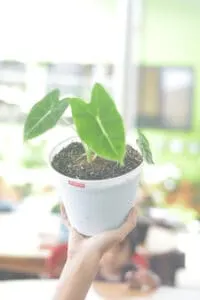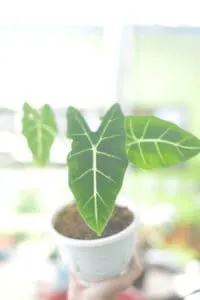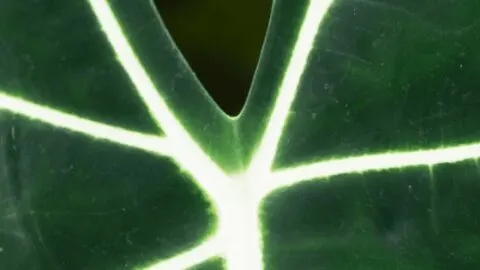Alocasia Frydek or Alocasia Micholitziana sometimes just called Alocasia Green Velvet is a stunning plant and one of my favorite Alocasias.
They do not thrive on neglect and Alocasia Frydek care is best suited for the intermediate green thumb.
Alocasia Frydek Care
To care for Alocasia Frydek provide it with bright indirect sunlight. Use a well-draining potting soil containing peat, humus, perlite sand, and pumice as well as orchid bark. The oil pH should be 5.5-6.5. Water once the topsoil almost dries out. The ideal temperature is 60-80°F ( 16°C – 27°C). Fertilize every two weeks with a balanced fertilizer in spring and summer. Provide a humidity level >50%.

Alocasia Frydek Care
Table of Contents
Alocasia Frydek Care Guide
Soil
Alocasia Frydek needs fertile well-draining soil that stays moist for an extended time and that is rich in humus or peat.
The soil needs to be well-draining.
So it is advised to add chunky bits to your potting soil such as perlite, pumice, and orchid bark.
This will ensure that the soil is well-draining.
The pH of your mix should ideally sit in the range of 5.5-6.5.
Your aim is to avoid at all costs any risk of root rot.
Root rot can cause a range of fungal infections that, when left undetected, will kill your plant.
Of course, detecting this is pretty difficult, because the rot takes place below the soil.
In order to keep your soil in optimal condition, try to leave the top layer to almost dry out between watering.
But this is where it gets tricky.
The Alocasia Frydek loves water, so you’re going to need to finely balance the water requirements with the risk of becoming soggy.
To ensure the soil has enough room to breathe, containerized Alocasia Frydek’s will need a couple of drainage holes in the bottom of the pot.
It’s a little tricky to get the soil conditions right for the Alocasia Frydek, but make sure you spend the time to do so.
If you stick to the watering schedule listed in this guide you will have gone a long way to keep the soil happy.
Now, your plant can get on to doing what it does best, which is growing – rapidly – lovely leaves.

Alocasia Frydek needs slightly moist soil to thrive
Light
Alocasia Frydek prefers bright indirect light. A couple of hours (3-4 hours) of direct sunlight in the morning is fine.
The perfect location to place your Alocasia Frydek is an east-facing window where the Alocasia will get some morning sun for a couple of hours and in the afternoon when the sun is stronger, it will still have bright but now more indirect light.
When placed in front of a south-facing window, you can use a thin curtain that will filter the light.
This way it will stay bright but the Frydek will not be exposed to the strong direct afternoon sun.
Watering
Alocasia Frydek likes the potting soil to remain slightly humid. Water just before the potting soil almost dries out.
Alocasias are growing in tropical forests and need thorough watering.
Skipping on a couple of waterings and you may risk that your Alocasia Frydek goes dormant.
Therefore do not skip watering and make sure that when you are watering, water right.
Make sure that the soil is well-draining and excess water can drain through the soil and will not stay in the pot.
Drainage holes are absolutely essential.
Water every time the topsoil is about to dry out.
Depending on where you live and your climate this will be about once a week. Reduce watering in winter.
Temperature
The ideal temperature for an Alocasia Frydek is between 60-80°F ( 16°C – 27°C).
The minimum temperature for Alocasia Frydek is 60°F (16°C). Below this temperature, your plant will be unhappy.
Humidity
Alocasia Frydek grows best in humidity >50%.
These Alocasias enjoy high humidity.
To ensure the beautiful leaves stay in prime condition and do not get show signs of browning use a humidifier at home if your humidity is very low.

A humidity above 50% is best for Alocasia Frydek to thrive
Fertilizer
To fertilize Alocasia Frydek use a balanced diluted fertilizer from spring to summer every 2-weeks.
A balanced fertilizer is a fertilizer where the three numbers are the same.
Eg. NPK 10-10-10 or 5-5-5.
Balanced fertilizers contain NPK where (N) stands for Nitrogen and is supporting leaf growth, (P) stands for Phosphorus and is inducing flowering, and (K) stands for Potassium and helps stem growth.
Propagation
Alocasia Fryedk propagation is best done by division.
Dig out your plant and separate the part from your plant that can be pulled apart.
Do this procedure preferably in spring when repotting your plant.
See below where we added a detailed step-by-step instruction guide on how to either propagate by division or bulbs.
Growth
Alocasia Frydek can grow up to 3-feet high.
Alocasia is very variable in size and there are specimen that gets to a size of 20-feet.
Potting
Use a pot with drainage holes for Alocasia Frydek as you will be watering frequently.
You absolutely want to avoid that water does not drain and will lead to soggy soil: This can lead to root rot symptoms.
Repotting
Alocasia Frydek is a plant that you are not in need of repotting frequently.
They like to stay slightly root-bound.
Only repot about every 2 years once your plants are mature. Use a pot that is 1-2 sizes bigger and completely renew the potting soil.
With these tips, you should be able to keep your Alocasia happy and thriving.
Once summer arrives or depending on your climate zone, you may even be able to grow your Alocasia Frydek outdoors.
About the term African Mask
Another Alocasia that is also called African Mask is Alocasia Polly.
Alocasia itself is a genus of 70 different species. Frydek is an Elephant’s Ear variation that is also called the Green Velvet Alocasia.
The Alocasia Frydek dark green to black leaves with prominent lateral veins that are a bright white.
The leaves can grow up to 18-inches long.
Alocasias are great house plants that give every apartment or house a jungle look.
They are also called African Mask plants as their leaves are shaped like, you guessed right, African Masks.
The plant care for Alocasia Friedek is best suited for the intermediate green thumb as work is needed to keep them happy.
This perennial rhizome plant is not the kind of plant that thrives on neglect.
Alocasia Frydek Bulb
Alocasia is bulbous or also called rhizomatous perennial.
When you are repotting Alocasias, you are confronted with these roundish bulbs in the soil that somewhat look like potatoes.
They can be attached or loose. Some of them will be attached to the roots of the plants.
Alocasia Frydek Flowering
Alocasia Frydek is a flowering plant, although they are mostly bought for their striking foliage.
Since Alocasia is an Aroid, it is producing a spathe and a spadix. These two components are the flowers of the Alocasia.
The spadix is fleshy and is composed of multiple little flowers whereas the spadix is a bract or modified leaf.
When the flowers get pollinated, berries are starting to form along the spadix.
It needs to be said that it is rather unlikely that these plants will flower inside.
You will need very warm and humid conditions that mirror the conditions of their natural habitat in Southeast Asia and Eastern Australia.
Alocasia Frydek Outdoor Care
Alocasia can be grown outdoors in USDA hardiness zones from 9b -11. Make sure that temperatures stay above 60°F (15°C).
As long as this is the case Alocasias will grow outdoors. Temperatures below this will cause the plants to go into dormancy.
Signs of Alocasia going into dormancy are yellow leaves and the loss of leaves without new growth happening.
If this happens in conjunction with low temperatures it is probably best to bring your plants indoors.
Most people will only be able to grow their Alocasias outdoors in summer.
If you are living in hardiness zones between 9b -11 you may grow your Alocasia Frydek outdoors all year round.
Alocasia Frydek Propagation
As with all plants, propagation is most successful in Spring and Summer where your Alocasia is not dormant and is in its main growth phase.
Let’s now look into two propagation methods.
Propagation by division and propagation by using bulbs.
Propagation by division
This is by far the simplest method of propagation.You can follow this step by step guide on how to propagate by division:
- Remove the Alocasia from its container
- Use chopsticks or any other instrument to remove the soil around the roots
- Look for a section with multiple corms or bulbs and divide it from your plant
- Pot both, your mother plant again and the divided section into a separate container
- Water after the division so the roots can start to grow into the new soil/container
As mentioned, this method is easy as you already have a full plant and only need to divide a section. Let’s now look into propagation from bulbs.
Propagation using bulbs
Alocasia is producing bulbs under the soil that can be used for propagation purposes.
No matter if you have bulbs with or without roots, both are potentially viable to produce new plants.
Make sure that you are separating the bulbs from the roots and that you leave the roots with the mother plant when trying to propagate your Alocasia Frydek form bulbs.
Healthy bulbs will be hard to the touch whereas mushy ones are goners.
Here is a step by step guide:
- Remove bulbs from the mother plant by cutting the bulbs off the roots that are attached to the main plant
- You are likely ending up with some bulbs that have roots and others that don’t have any. That is fine
- In case you find any bulbs that are mushy, discard them. This is most likely caused by soil that is too wet leading to bulbs and potentially also root rot.
- Put the bulbs into well-draining soil. A soil mix with chunky bits using perlite, pumice or sand is best
- Make sure the soil stays humid but not soaking wet
- Water every few weeks before the soil dries out but be aware the beginning the bulbs have no roots and do thus not overwater.
- You can use a plastic bag (transparent) or plastic hood that you place on your pot to create a greenhouse effect: This way you will keep the soil and air humid.
- If you use some kind of hood, open it every couple of days for a few minutes to ensure sufficient airflow.
- Within a couple of weeks, (2-4 weeks) roots and a stem will start to grow. Don’t be disappointed if not every bulb will be a success and produce a new plant. This is absolutely normal.
- Once a new stalk is emerging and leaves are forming you know that your bulb has rooted and you have just propagated your Alocasia Frydek. Congrats!
Alocasia Frydek Problems
The Elephant’s Ear is a finicky plant and it is not unusual that caregivers are getting stressed, worried, and annoyed at some stage when caring for this stunning plant.
In order to support you as much as we can, we have listed the most common problems with the Alocasia Frydek below.
You will learn to interpret the different reasons for certain things correctly and we will equip you with the knowledge to bring your Alocasia back to health.
Spider Mites
Never a nice sight on any plant, these pesky bugs mean trouble for your Alocasia Frydek.
They live on the underside of leaves can be either pale or red and are very small oval-shaped insects.
Telltales of a Spider Mite infestation are small webs, yellow streaks, and yellow patches on leaves.
Another one, of course, is if you spot the insects themselves. The search is best done by using a magnifying glass.
A great trick is to put s sheet of paper underneath a plant and shake on the leaves.
The pests will come right off.
If the infestation gets really bad, whole leaves can start to fall off your Alocasia Frydek.
How to prevent and counter Spider Mites
As spider mites thrive in dry conditions, the first suggestion would be to increase the humidity around your plant as much as possible.
This can be done by regularly misting your plant, placing the pot in a pebble tray, or using a humidifier.
The misting part is of importance here as it will help to counter the Spider mites.
Further things you can do to get rid of a Spider Mite infestation:
- Wash your plant including leaves and stems off every day with a sponge or wet cloth
- Use a cotton swab with rubbing alcohol as this will kill the Spider Mites right away
- Get rid of infested leaves and trash them
- Use running water to wash Spider Mites away
- Use other bugs that prey on Spider Mites such as Lady Bugs
- Apply Neem Oil on the Alocasia Micholitziana
My Alocasia Frydek is Drooping- Why?
This is a tricky one as drooping can be a cause of over-or underwatering.
You therefore first have to find out which one is the cause for the drooping.
Stick your finger into the soil and check if the soil is soggy.
This is when the soil is soaking wet and a lot of soil will stick to your finger.
If that is the case, your Elephant’s Ear is most likely overwatered.
On the contrary, when no soil stays but on your finger after sticking it into the soil and it feels dry, chances are that you haven’t watered for quite a while.
Interestingly we have the perception that almost all if not all the plants are dying because people are not watering them.
This may certainly be the case for many plants, but it is important to realize that most houseplants are dying from overwatering.
Because overwatering leads to root rot. Once your plants have root rot they will go downhill quickly.
My Alocasia has Brown Tips
The most common reason for brown leaf tips or edges on Alocasia Frydek is a lack of humidity.
Increase the humidity by using a humidifier or by spraying your plan daily.
These plants grow in warm humid conditions in nature and dry air can cause leaf tips to brown.
Dormancy – My plant went dormant
Alocasia Frydek may go dormant when it is stressed. A reason for being stressed could be if the plant is too dry for too long.
In addition, Alocasias will go dormant in the winter months.
Reduce watering during this period and do not report or divide your plant during this time.
Losing Leaves
Losing leaves can be a normal occurrence when dealing with immature plants as they often lose an older leaf when a newer one is produced.
The reason is that the stalks of the Alocasia Frydek are expanding constantly.
The growing stems are leading the smaller leaves to fall off. Once your Alocasia becomes more mature, it will be able to maintain more leaves.
In case the reason is not that it is an immature plant and older leaves are falling off, the reason could very well be that you are overwatering your plant. Make sure the soil is at most moist but never soggy.
Leaves turning yellow
Yellowing leaves are often an indicator that your plant is too wet and that you are watering too often.
Also the opposite, a plant that is kept too dry might produce yellow leaves.
From our experience, yellow leaves are mostly a function of overwatering.
If the plant was kept to dry it would be easy to tell from sticking your finger into the dirt.
A different reason lastly could be a pest infestation such as spider mites.
As will all signs the Alocasia Frydek provides you, you will need to identify the root cause, pun intended.
Check the soil for humidity/dryness, look at the leaves with a magnifying glass to spot any pests and with just these two steps you will identify the cause in most cases.
Yet other reasons might be that you have to adjust your fertilization regiment or your plant might be stressed and go into dormancy.
Yellow / Black Spots
Yellow spots on your plant are a sign of either over-or underwatering. Check your watering schedule and make out which of the two reasons it may be.
It doesn’t hurt to stick your finger into the dirt to verify for yourself if the soil is either dry or soaking wet.
Spots with a yellow halo around them are often a sign of a fungal or bacterial infection caused by overwatering that is leading to root rot which is caused by bacteria in the soil.
Toxicity of Alocasia Frydek
Alocasia plants are toxic to cats, dogs, and horses according to ASPCA, and can lead to oral irritation, pain, and swelling.
In addition, a common symptom is vomiting and problems swallowing.
Alocasia Frydek vs. Alocasia Polly
Don’t get confused if you find a different plant- known as the Alocasia Polly – being touted as the African Mask.
In fact, both plants are deserving of the name.
The shape of the leaves on both variants is of a similar structure.
You may also find the Alocasia Polly offered as the Alocasia Poly with one L.
Both plants do look pretty similar, and the untrained eye may not be able to tell them apart.
But whilst their color and shape might have you thinking they are one and the same, there are subtle differences.
The Alocasia Polly for one is more readily available, the Frydek being a little harder to get your hands on. For some reason, it is a much rarer plant.
The Alocasia Polly is blessed with leaves with a glossy sheen.
The Frydek however feels – and looks – more velvety to the touch.
And the veins are different too – the Alocasia Polly’s veins being broader and more striking in appearance.
Generally, there are more of them too. The Frydek typically has one on each leaf down the middle.
Growth is different too. Whilst the Alocasia Frydek will grow to 3 feet (36 inches), the Alocasia Polly will probably only reach about 18 inches, maybe 20 inches on occasion.
It is more of a compact plant overall.
The leaves will grow however to around the same size, the Frydek’s being usually just a couple of inches longer.
So pick the Polly if you have space restrictions or prefer a glossier look in appearance.
Overall, however, you would do well to get your hands on the Alocasia Frydek – as it is almost a collector’s item due to its availability.
The care requirements – from light to soil, watering to humidity are generally the same for both variants. Both plants will also flower too – rarely – on occasion, but it does happen.
For that reason you may want to get one of each and grow them together, noticing the differences as they mature.
Whichever one you may choose, be sure to follow the care instructions given here carefully to keep them looking their best.
Whatever you end up with, either choice is sure to be a decent one if you can keep them alive.
Top 5 care tips for the Alocasia Frydek
Now you’ve checked out the main care aspects for the Alocasia Frydek, let’s recap and see which ones are make or break for this beautiful plant.
As we mentioned, you need a little bit of a green thumb with the Frydek, and beginners to plant care may struggle.
Get the basics right here and you will enjoy a plant that not only is pleasing to the eye but also rewards your efforts with rapid growth in the summer months.
To summarize, here are the top 5 care tips summarized for you. If you don’t do anything else for this plant, at least do this:
- Soil: Must be well-draining, slightly acidic, and maintain moisture
- Water: Must be frequently watered, but not overly so. Let the top become nearly dry before watering again. Ease up on the schedule during the winter
- Light: Can tolerate a little early morning sun, but generally keep this little beauty in bright indirect sunlight
- Temperature: You shouldn’t let the temperature drop below 60 degrees Fahrenheit. Keep it above this, up to 80 degrees Fahrenheit
- Humidity levels: Tropical in nature, the Alocasia Frydek needs to be kept in a humid environment. Mist the leaves if you must or buy yourself a humidifier
Of course, to get optimal growth and a very happy plant, consider also fertilizer, fungal control, and checking for pests and insects.
It takes a little time, but we are sure it will be well worth it.
Frequently Asked Questions about Alocasia Frydek Care
Why is my Alocasia Frydek Drooping?
The main cause of drooping for Alocasia Frydek is over-or underwatering.
Is the Alocasia Frydek poisonous?
Alocasia Frydek is toxic and is poisonous to cats, dogs, and horses.
Is Alocasia Frydek safe for cats?
Alocasia Frydek is toxic to cats and can lead to oral irritation, swelling, and vomiting. Therefore make sure your cats are keeping their distance from this houseplant.

Daniel has been a plant enthusiast for over 20 years. He owns hundreds of houseplants and prepares for the chili growing seasons yearly with great anticipation. His favorite plants are plant species in the Araceae family, such as Monstera, Philodendron, and Anthurium. He also loves gardening and is growing hot peppers, tomatoes, and many more vegetables.


